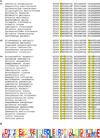The 4-cysteine zinc-finger motif of the RNA polymerase regulator DksA serves as a thiol switch for sensing oxidative and nitrosative stress
- PMID: 24354846
- PMCID: PMC4053250
- DOI: 10.1111/mmi.12498
The 4-cysteine zinc-finger motif of the RNA polymerase regulator DksA serves as a thiol switch for sensing oxidative and nitrosative stress
Abstract
We show that thiols in the 4-cysteine zinc-finger motif of DksA, an RNA polymerase accessory protein known to regulate the stringent response, sense oxidative and nitrosative stress. Hydrogen peroxide- or nitric oxide (NO)-mediated modifications of thiols in the DksA 4-cysteine zinc-finger motif release the metal cofactor and drive reversible changes in the α-helicity of the protein. Wild-type and relA spoT mutant Salmonella, but not isogenic dksA-deficient bacteria, experience the downregulation of r-protein and amino acid transport expression after NO treatment, suggesting that DksA can regulate gene expression in response to NO congeners independently of the ppGpp alarmone. Oxidative stress enhances the DksA-dependent repression of rpsM, while preventing the activation of livJ and hisG gene transcription that is supported by reduced, zinc-bound DksA. The inhibitory effects of oxidized DksA on transcription are reversible with dithiothreitol. Our investigations indicate that sensing of reactive species by DksA redox active thiols fine-tunes the expression of translational machinery and amino acid assimilation and biosynthesis in accord with the metabolic stress imposed by oxidative and nitrosative stress. Given the conservation of Cys(114) , and neighbouring hydrophobic and charged amino acids in DksA orthologues, phylogenetically diverse microorganisms may use the DksA thiol switch to regulate transcriptional responses to oxidative and nitrosative stress.
© 2013 John Wiley & Sons Ltd.
Conflict of interest statement
The authors do not have a conflict of interest to declare.
Figures







Similar articles
-
Redox-Active Sensing by Bacterial DksA Transcription Factors Is Determined by Cysteine and Zinc Content.mBio. 2016 Apr 19;7(2):e02161-15. doi: 10.1128/mBio.02161-15. mBio. 2016. PMID: 27094335 Free PMC article.
-
The DnaK/DnaJ Chaperone System Enables RNA Polymerase-DksA Complex Formation in Salmonella Experiencing Oxidative Stress.mBio. 2021 May 11;12(3):e03443-20. doi: 10.1128/mBio.03443-20. mBio. 2021. PMID: 33975942 Free PMC article.
-
DksA-Dependent Transcriptional Regulation in Salmonella Experiencing Nitrosative Stress.Front Microbiol. 2016 Mar 31;7:444. doi: 10.3389/fmicb.2016.00444. eCollection 2016. Front Microbiol. 2016. PMID: 27065993 Free PMC article.
-
Genetic Blueprint for Stringent Response in Betaproteobacterial Aromatoleum/Azoarcus/Thauera Cluster.Microb Physiol. 2025;35(1):30-49. doi: 10.1159/000546200. Epub 2025 May 7. Microb Physiol. 2025. PMID: 40334648 Review.
-
Redox active thiol sensors of oxidative and nitrosative stress.Antioxid Redox Signal. 2012 Nov 1;17(9):1201-14. doi: 10.1089/ars.2012.4522. Epub 2012 Mar 15. Antioxid Redox Signal. 2012. PMID: 22257022 Free PMC article. Review.
Cited by
-
DksA-DnaJ redox interactions provide a signal for the activation of bacterial RNA polymerase.Proc Natl Acad Sci U S A. 2018 Dec 11;115(50):E11780-E11789. doi: 10.1073/pnas.1813572115. Epub 2018 Nov 14. Proc Natl Acad Sci U S A. 2018. PMID: 30429329 Free PMC article.
-
Persister formation in Escherichia coli can be inhibited by treatment with nitric oxide.Free Radic Biol Med. 2016 Apr;93:145-54. doi: 10.1016/j.freeradbiomed.2016.02.003. Epub 2016 Feb 2. Free Radic Biol Med. 2016. PMID: 26849946 Free PMC article.
-
Gre factors help Salmonella adapt to oxidative stress by improving transcription elongation and fidelity of metabolic genes.PLoS Biol. 2023 Apr 4;21(4):e3002051. doi: 10.1371/journal.pbio.3002051. eCollection 2023 Apr. PLoS Biol. 2023. PMID: 37014914 Free PMC article.
-
Nitric Oxide Inhibition of Rickettsia rickettsii.Infect Immun. 2021 Nov 16;89(12):e0037121. doi: 10.1128/IAI.00371-21. Epub 2021 Sep 7. Infect Immun. 2021. PMID: 34491789 Free PMC article.
-
Bacterial Stress Responses during Host Infection.Cell Host Microbe. 2016 Aug 10;20(2):133-43. doi: 10.1016/j.chom.2016.07.009. Cell Host Microbe. 2016. PMID: 27512901 Free PMC article. Review.
References
-
- Aberg A, Shingler V, Balsalobre C. Regulation of the fimB promoter: a case of differential regulation by ppGpp and DksA in vivo. Mol Microbiol. 2008;67:1223–1241. - PubMed
-
- Bae JB, Park JH, Hahn MY, Kim MS, Roe JH. Redox-dependent changes in RsrA, an anti-sigma factor in Streptomyces coelicolor: zinc release and disulfide bond formation. J Mol Biol. 2004;335:425–435. - PubMed
Publication types
MeSH terms
Substances
Grants and funding
- I01 BX002073/BX/BLRD VA/United States
- R01 AI073971/AI/NIAID NIH HHS/United States
- AI052066/AI/NIAID NIH HHS/United States
- R01 AI039557/AI/NIAID NIH HHS/United States
- AI039557/AI/NIAID NIH HHS/United States
- T32 GM008730/GM/NIGMS NIH HHS/United States
- R56 AI054959/AI/NIAID NIH HHS/United States
- R01 AI044486/AI/NIAID NIH HHS/United States
- R01 AI054959/AI/NIAID NIH HHS/United States
- AI077645/AI/NIAID NIH HHS/United States
- AI073971/AI/NIAID NIH HHS/United States
- T32 AI052066/AI/NIAID NIH HHS/United States
- R01 AI083646/AI/NIAID NIH HHS/United States
- AI083646/AI/NIAID NIH HHS/United States
- R56 AI077645/AI/NIAID NIH HHS/United States
- R01 AI052237/AI/NIAID NIH HHS/United States
- R01 AI075093/AI/NIAID NIH HHS/United States
- AI54959/AI/NIAID NIH HHS/United States
- AI052237/AI/NIAID NIH HHS/United States
- AI075093/AI/NIAID NIH HHS/United States
LinkOut - more resources
Full Text Sources
Other Literature Sources
Molecular Biology Databases

